推荐-营销学原理终考卷英1 精品
- 格式:doc
- 大小:72.50 KB
- 文档页数:9
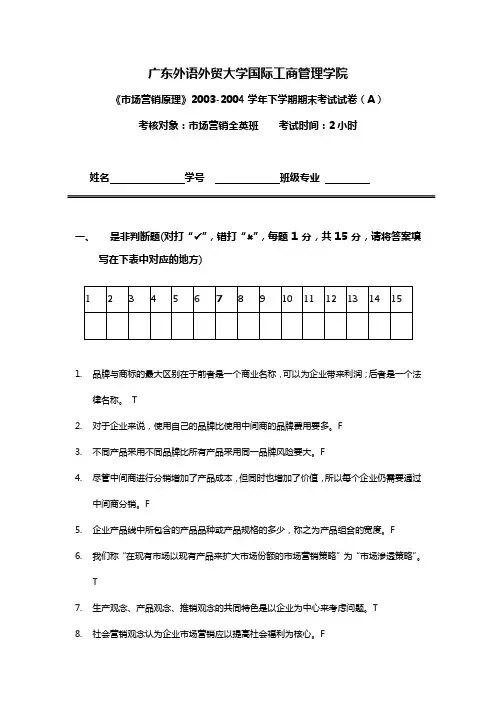
广东外语外贸大学国际工商管理学院《市场营销原理》2003-2004学年下学期期末考试试卷(A)考核对象:市场营销全英班考试时间:2小时姓名学号班级专业一、是非判断题(对打‚✓‛,错打‚✗‛,每题1分,共15分,请将答案填写在下表中对应的地方)1.品牌与商标的最大区别在于前者是一个商业名称,可以为企业带来利润;后者是一个法律名称。
T2.对于企业来说,使用自己的品牌比使用中间商的品牌费用要多。
F3.不同产品采用不同品牌比所有产品采用同一品牌风险要大。
F4.尽管中间商进行分销增加了产品成本,但同时也增加了价值,所以每个企业仍需要通过中间商分销。
F5.企业产品线中所包含的产品品种或产品规格的多少,称之为产品组合的宽度。
F6.我们称‚在现有市场以现有产品来扩大市场份额的市场营销策略‛为‚市场渗透策略‛。
T7.生产观念、产品观念、推销观念的共同特色是以企业为中心来考虑问题。
T8.社会营销观念认为企业市场营销应以提高社会福利为核心。
F9.SWOT分析法是指市场吸引力和企业实力分析的方法。
F10.大公司比小公司更易盈利。
F11.价值链是一系列互不相同但又互相关联的经济活动的总和。
F12.任何产品都会经历产品生命周期的四个阶段。
F13.市场营销理论中的推销观念强调:企业的一切行为要以市场需要为出发点,以满足市场需要为归宿。
F14.在产品生命周期四个阶段中,销量最大的阶段是成长期。
F15.延长产品生命周期就是设法延长该周期中的各个时期。
F1.消费品市场的特点是 BA 市场较集中B 购买人数多而散C专用性较强 D 购买决策常为集体决策2.包装是‚无声的推销员‛,说明了包装最主要的功能是 CA、包装可以保护商品B、包装可以提高商品价值C、包装可以促进销售,引起消费者注意、激发消费者的购买欲望D、包装影响商品销售,会增加商品的成本3.产品组合中产品项目(items)的多少称为 BA、产品组合的广度B、产品组合的长度C、产品组合的深度D、产品组合的相关度4.下面竞争中属于行业竞争的是 BA、本田——丰田B、本田——摩托车、自行车、卡车C、本田——汽车制造商D、本田——主要耐用消费品、国外度假、新房产公司竞争5.小摊贩在卖东西时,对于买主觉得价格太高、希望降价的要求常作这样的解释:‚这货进价就高,赚不了几个钱。
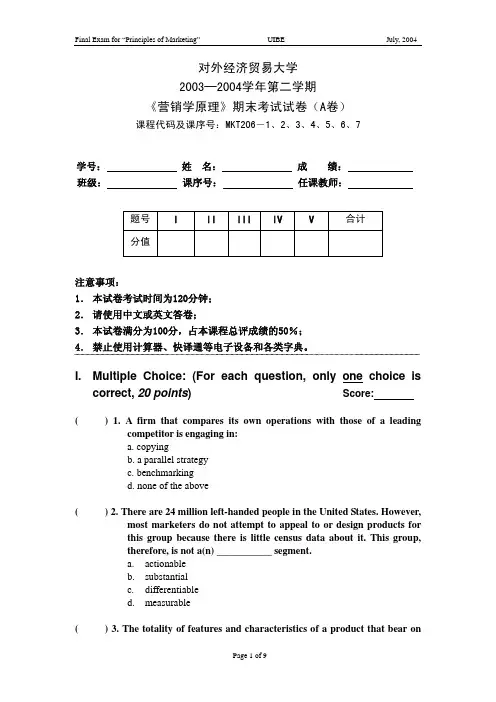
对外经济贸易大学2003─2004学年第二学期《营销学原理》期末考试试卷(A卷)课程代码及课序号:MKT206-1、2、3、4、5、6、7学号: 姓 名: 成 绩: 班级: 课序号: 任课教师:题号I II III IV V 合计分值注意事项:1.本试卷考试时间为120分钟;2.请使用中文或英文答卷;3.本试卷满分为100分,占本课程总评成绩的50%;4.禁止使用计算器、快译通等电子设备和各类字典。
I. Multiple Choice: (For each question, only one choice iscorrect, 20 points) Score:( ) 1. A firm that compares its own operations with those of a leading competitor is engaging in:a. copyingb. a parallel strategyc. benchmarkingd. none of the above( ) 2. There are 24 million left-handed people in the United States. However, most marketers do not attempt to appeal to or design products forthis group because there is little census data about it. This group,therefore, is not a(n) ___________ segment.a. actionableb. substantialc. differentiabled. measurable( ) 3. The totality of features and characteristics of a product that bear onits ability to satisfy stated or implied needs is called:a. value.b. quality.c. the core product.d. none of the above.( ) 4. An industry characterized by many buyers and sellers trading a homogeneous commodity, where no single buyer or seller has muchinfluence on the going market price, operates in:a. pure competition.b. monopolistic competition.c. target profit pricing.d. monopoly.( ) 5. ______ data have the characteristics of being relatively cheap and quick to obtain.a. Syndicatedb. Market intelligencec. Primaryd. Secondary( ) 6. Promotion, contact, and matching are all functions of:a. branding.b. the distribution channel.c. test marketing.d. logistics.( ) 7. The performance a consumer perceives in a product relative to her expectations is the source of:a. customer satisfaction.b. customer value.c. customer demand.d. customer need.( ) 8. A good, though expensive, sales-promotion tool to use to introduce a new consumer product, such as a bath soap, is:a. coupons.b. samples.c. premiums.d. contests.( ) 9. _________ provide the resources that a company needs to produce goods and services.a. Distributorsb. Banksc. Suppliersd. Resellers( ) 10. The ______ is all the actors and forces outside marketing that effecta marketer's ability to develop and maintain successful relationshipswith target customers.a. microenvironmentb. external environmentc. marketing environmentd. macroenvironment( ) 11. _____ are people who have so many resources that they can indulge in many pursuits.a. Fulfilledsb. Achieversc. Actualizersd. Experiencers( ) 12. A _____ sales force structure is built around the individual lines produced by a company.a. productb. customerc. territoriald. consumer( ) 13. The ___________________ are skeptical and they adopt an innovative product only after a majority of people have tried it.a. early adoptersb. early majorityc. late majorityd. laggards( ) 14. The main difference between merchant wholesalers and agents and brokers is that:a. merchant wholesalers take title to the goods they sell while agentsand brokers do not.b. agents and brokers take title to the goods they sell while merchantwholesalers do not.c. merchant wholesalers represent buyers while agents and brokersrepresent sellers.d. agents and brokers do not have to worry about store atmospherewhile merchant wholesalers do.( ) 15. A _____ produces a lot of funds that a business uses to pay its bills and support other business areas that need investment.a. dogb. cash cowc. stard. question mark( ) 16. The proper order of the traditional product life-cycle is:a. introduction, growth, maturity, decline.b. introduction, maturity, growth, decline.c. decline, maturity, growth, introduction.d. introduction, decline, growth, maturity.( ) 17. Any paid form of nonpersonal communication is known as:a. publicity.b. sales promotions.c. advertising.d. personal selling.( ) 18. Your SUVs quickly grow popular because your first-rate engineers designed vehicles, which, in virtually every case, perform at the levelyour marketers claim they will. In other words, your SUVs possesshigh:a. performance quality.b. brand quality.c. conformance quality.d. extension quality.( ) 19. You market air-conditioning systems and their servicing to businesses. One of your long-time clients has built a new wing on itsoffice building and wants your firm to upgrade its old system andextend the upgraded system into the new wing. Your client has madewhat sort of buying decision?a. straight rebuyb. new-taskc. system buyd. modified rebuy( ) 20. Shirtco, a manufacturer of men's fashion shirts, has experienced an increase in demand for its product line, and the sales forecastindicates a continued upward trend during the next season. The bestseller in the line is made from a special fabric produced by only onesupplier, who has just raised prices by 20%. Fabric represents 15%of the production cost of the shirt. Another textile mill offers tosupply fabric of comparable quality, but different material, at oldprice. Market research indicates the new fabric would be acceptedby consumers, but several changes would be required in production.Shirtco selects to buy the old fabric from the old supplier at thehigher price. This is an example ofa. short-run inelasticity.b. acceleration principle.c. derived demand.d. professional purchasing.II. True or False (10points) Score:()1. You want to start an online bookstore. Because every person effectively constitutes a market, you can target them through mass marketing, offeringeach customer a product that suits his or her needs.()2. Market nichers serve small segments not served by other firms.()3. The aim of total quality management (TQM) is to ensure that products are completely free of defects (缺陷).()4. Maintaining top-of-mind product awareness is the purpose of reminder advertising.()5. The majority of companies use a straight salary compensation plan.()6. Social class is determined only by one's income.()7. Convenience stores are now trying to change their image and attract more female customers.()8. The actual product consists of the brand name, features, quality level, and packaging.()9. The final step in new-product development is commercialization.()10. All the organizations that buy goods and services either for resale or rental, or that produce other goods and services, are called the businessmarket.III. Define the following concepts briefly. (12 points)Score:1.Marketing (3 points)2.Strategic business unit (SBU) (3 points)3.Marketing information system (MIS) (3 points)4.Opinion leader (3 points)IV. Answer the following questions briefly. (18 points)Score:1.What are the basic differences between selling concept and marketing concept? (6 points)2.Describe the kinds of horizontal (横向)and vertical (纵向)channel conflict that might occur in the automobile industry? (6 points)3.Classify and explain the advertising objectives by its primary purpose. (6 points)V. C ase Analysis(40 points) Score:1. (20 points)Suppose a mobile phone manufacturer has the following costs and expected price:Variable cost $50Fixed costs $1,000,000Expected price $100Now answer the following questions:(1)Suppose the manufacturer wants to breakeven, that is, for total revenue to covertotal cost, at least how many units of the phone must be sold at this price? (7points)(2)Calculate the total revenue at the breakeven point. (6 points)(3)If the manufacture wants to make a target profit of $500,000, how many units ofthe phone must be sold at this price? (7 points)2. Product Mix of Unilever China (20 points)Product line managers are often concerned with managing the length, width and consistency of their product lines. Some companies have very wide product mix, while others have narrow but long product lines. The following table illustrates the product mix of Unilever China.Category Brand Hair Care Lux (力士), Hazeline (夏士莲)Skin Care Hazeline (夏士莲), Pond’s (玉兰由), Dove (多芬), Vaseline (凡士林) Personal Cleaning Lux (力士), Dove (多芬)Oral Care Zhonghua (中华), Signal (洁诺)Ice Cream Wall’s (和路雪)(立顿), Jinghua (京华)Tea Lipton(家乐), Laocai (老蔡)Savory (调味品) KnorrSpreads & DressingsSkippy (四季宝), Hellmann (好乐门)(食伴酱)(奥妙), Comfort (金纺)Laundry (洗衣) OmoNow answer the following questions:1) Define the width, length, and consistency of a product mix. Describe the productmix of Unilever China in terms of width, length, and consistency. (9 points)2) What brand strategy (line extensions, brand extensions, multibrands or new brands)does Unilever apply to its Skin Care line? Explain the strength and weakness of such brand strategy. (11 points)-- END --。
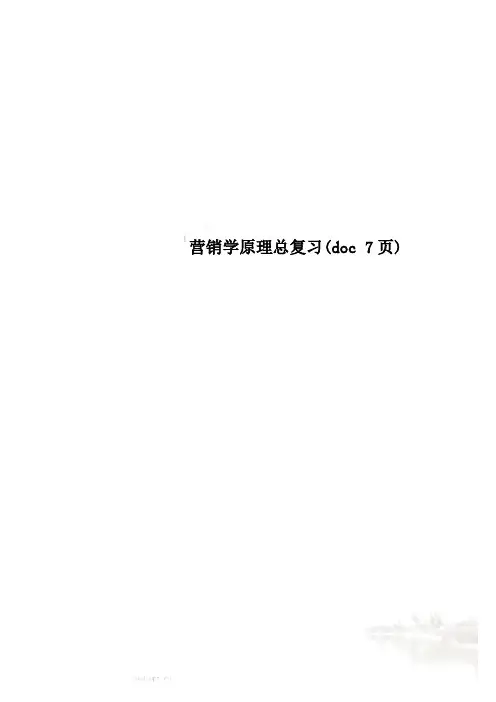
营销学原理总复习(doc 7页)营销学原理总复习题第一章市场营销概论P2~3 什么是市场营销,如何理解市场营销传统定义:引导货物与服务从生产者流转到消费者或用户所进行的一切企业活动。
现代定义:对思想、货物和服务进行构想、定价、促销和分销的计划和实施的过程,从而产生满足个人和组织目标的交换。
菲利普•科特勒的定义:个人和群体通过创造以及同其他个人和群体交换产品和价值而满足需求和欲求的一种社会的和管理的过程。
(菲利普•科特勒是市场营销学之父)P5 各种需求状况及其营销任务P12 市场营销的核心概念:需要 欲望 需求 产品 价值 交换 交易P15~16 市场(营销)观念的类型及其特点如何1. 生产观念的特点(“三不主义”):① 注重企业自身条件而不注重市场需求 需求状况 营销任务 任务名称 否定需求 解释需求 转化型营销 无需求 产生需求 刺激性营销 潜在需求 发展需求 发展性营销 退却需求 再生需求 再生性营销 不规则需求 配合需求 同步性营销 充分需求 保持需求 维持性营销 过度需求 减少需求 减低营销 无益需求 消灭需求 反向营销②注重产品生产而不注重产品销售③注重产品数量而不注重产品质量2.产品观念的特点(“二不主义”):①不仅注重了生产数量,还注重了产品质量②以生产为中心,不注重市场需求,不注重产品销售3.销售观念的特点:采用各种强迫和引诱手段把已不受市场欢迎的产品销售出去,并且“货物出门,概不退换”。
4.营销观念的特点:首先分析顾客需要,确定目标市场,然后通过产品设计开发、生产、促销和售后服务等整体营销活动满足目标市场需要。
5.社会营销观念的特色:视野广,涉及企业的经济利益和社会责任的平衡问题。
第二章顾客价值与顾客满意p33~35 什么是顾让渡价值?顾客让渡价值的构成因素有哪些?顾客让渡价值:1.整体顾客价值:①产品价值②服务价值③人员价值④形象价值2.整体顾客成本:①货币成本②时间成本③体力成本④精神成本p39~40 如何提高顾客的让渡价值?1.在不改变整体顾客成本的条件下,通过改进产品、改善服务、提高人员素质、提升企业形象来提高整体顾客价值。
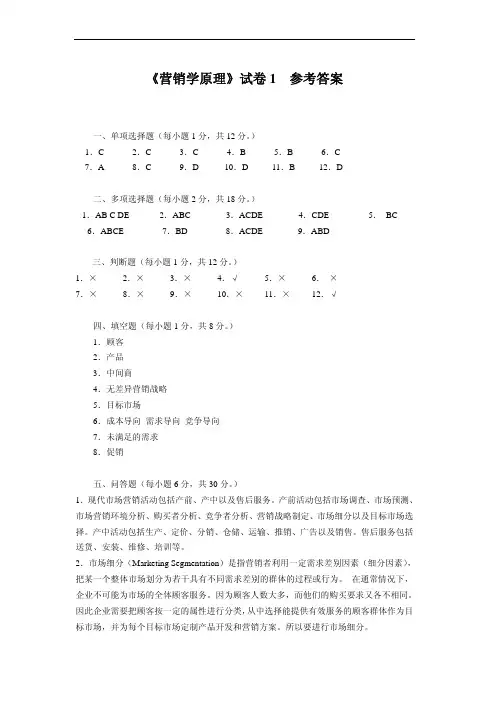
《营销学原理》试卷1 参考答案一、单项选择题(每小题1分,共12分。
)1.C 2.C 3.C 4.B 5.B 6.C7.A 8.C 9.D 10.D 11.B 12.D二、多项选择题(每小题2分,共18分。
)1.AB C DE 2.ABC 3.ACDE 4.CDE 5. BC6.ABCE 7.BD 8.ACDE 9.ABD三、判断题(每小题1分,共12分。
)1.×2.×3.×4.√5.×6.×7.×8.×9.× 10.× 11.× 12.√四、填空题(每小题1分,共8分。
)1.顾客2.产品3.中间商4.无差异营销战略5.目标市场6.成本导向需求导向竞争导向7.未满足的需求8.促销五、问答题(每小题6分,共30分。
)1.现代市场营销活动包括产前、产中以及售后服务。
产前活动包括市场调查、市场预测、市场营销环境分析、购买者分析、竞争者分析、营销战略制定、市场细分以及目标市场选择。
产中活动包括生产、定价、分销、仓储、运输、推销、广告以及销售。
售后服务包括送货、安装、维修、培训等。
2.市场细分(Marketing Segmentation)是指营销者利用一定需求差别因素(细分因素),把某一个整体市场划分为若干具有不同需求差别的群体的过程或行为。
在通常情况下,企业不可能为市场的全体顾客服务。
因为顾客人数大多,而他们的购买要求又各不相同。
因此企业需要把顾客按一定的属性进行分类,从中选择能提供有效服务的顾客群体作为目标市场,并为每个目标市场定制产品开发和营销方案。
所以要进行市场细分。
市场细分的作用是有利于发现市场机会,是选择目标市场的基础,有利于企业正确制定营销组合策略,提高企业的竞争力。
消费者市场细分的标准包括地理环境因素、人口因素、心理因素、行为因素等。
3.企业要赢得顾客并战胜竞争者,必须了解顾客在面对纷繁复杂的商品、品牌、价格、供应商时,如何进行选择并作出决策的。
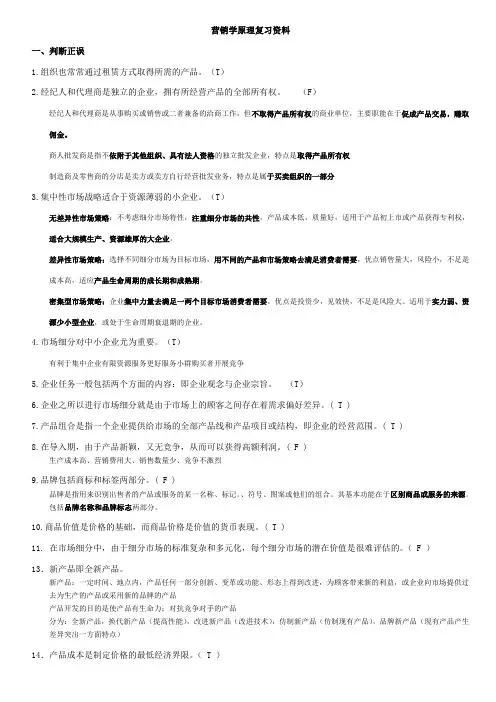
营销学原理复习资料一、判断正误1.组织也常常通过租赁方式取得所需的产品。
(T)2.经纪人和代理商是独立的企业,拥有所经营产品的全部所有权。
(F)经纪人和代理商是从事购买或销售或二者兼备的洽商工作,但不取得产品所有权的商业单位,主要职能在于促成产品交易,赚取佣金。
商人批发商是指不依附于其他组织、具有法人资格的独立批发企业,特点是取得产品所有权制造商及零售商的分店是卖方或卖方自行经营批发业务,特点是属于买卖组织的一部分3.集中性市场战略适合于资源薄弱的小企业。
(T)无差异性市场策略:不考虑细分市场特性,注重细分市场的共性,产品成本低,质量好,适用于产品初上市或产品获得专利权,适合大规模生产、资源雄厚的大企业。
差异性市场策略:选择不同细分市场为目标市场,用不同的产品和市场策略去满足消费者需要,优点销售量大,风险小,不足是成本高,适应产品生命周期的成长期和成熟期。
密集型市场策略:企业集中力量去满足一两个目标市场消费者需要,优点是投资少,见效快,不足是风险大。
适用于实力弱、资源少小型企业,或处于生命周期衰退期的企业。
4.市场细分对中小企业尤为重要。
(T)有利于集中企业有限资源服务更好服务小群购买者开展竞争5.企业任务一般包括两个方面的内容:即企业观念与企业宗旨。
(T)6.企业之所以进行市场细分就是由于市场上的顾客之间存在着需求偏好差异。
( T )7.产品组合是指一个企业提供给市场的全部产品线和产品项目或结构,即企业的经营范围。
( T )8.在导入期,由于产品新颖,又无竞争,从而可以获得高额利润。
( F )生产成本高、营销费用大、销售数量少、竞争不激烈9.品牌包括商标和标签两部分。
( F )品牌是指用来识别出售者的产品或服务的某一名称、标记。
、符号、图案或他们的组合。
其基本功能在于区别商品或服务的来源。
包括品牌名称和品牌标志两部分。
10.商品价值是价格的基础,而商品价格是价值的货币表现。
( T )11. 在市场细分中,由于细分市场的标准复杂和多元化,每个细分市场的潜在价值是很难评估的。
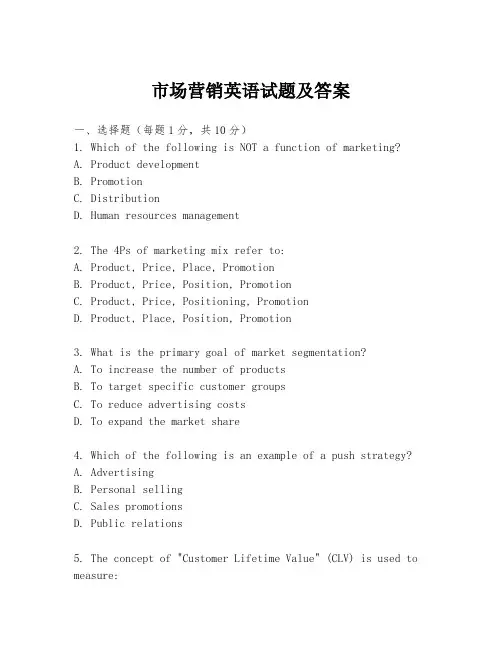
市场营销英语试题及答案一、选择题(每题1分,共10分)1. Which of the following is NOT a function of marketing?A. Product developmentB. PromotionC. DistributionD. Human resources management2. The 4Ps of marketing mix refer to:A. Product, Price, Place, PromotionB. Product, Price, Position, PromotionC. Product, Price, Positioning, PromotionD. Product, Place, Position, Promotion3. What is the primary goal of market segmentation?A. To increase the number of productsB. To target specific customer groupsC. To reduce advertising costsD. To expand the market share4. Which of the following is an example of a push strategy?A. AdvertisingB. Personal sellingC. Sales promotionsD. Public relations5. The concept of "Customer Lifetime Value" (CLV) is used to measure:A. The value of a customer's first purchaseB. The value of a customer's total purchases over timeC. The value of a customer's most recent purchaseD. The value of a customer's future purchases6. What is the term used to describe the process of identifying, anticipating, and satisfying customer requirements efficiently and effectively?A. Market researchB. Customer relationship managementC. MarketingD. Product management7. A marketing campaign that focuses on the benefits of the product to the customer is known as:A. Feature-based marketingB. Benefit-based marketingC. Need-based marketingD. Value-based marketing8. Which of the following is a type of market structure?A. MonopolyB. OligopolyC. Perfect competitionD. All of the above9. In marketing, the term "brand equity" refers to:A. The value of the brand's assetsB. The brand's market shareC. The brand's advertising budgetD. The brand's customer base10. Which of the following is a key element of the marketing mix for services?A. Service qualityB. Service priceC. Service promotionD. All of the above二、填空题(每题1分,共5分)11. The SWOT analysis is a tool used to identify a company's strengths, weaknesses, opportunities, and ________.12. The marketing concept is based on the idea that the key to achieving organizational goals is to determine the needs and wants of ________ and society.13. A ________ is a marketing strategy that involves creatinga unique image or identity in the minds of consumers.14. The term "market penetration" refers to increasing sales of existing products to existing customers without ________.15. The marketing mix for tangible goods is often referred to as the "4Ps," while for services it is sometimes called the "7Ps," which includes the additional elements of people, process, and ________.三、简答题(每题5分,共10分)16. Briefly explain the concept of market orientation and its importance in business.17. Describe the steps involved in the marketing research process.四、案例分析题(15分)18. (a) Assume you are a marketing manager for a new smartphone brand. Discuss the factors you would consider when setting the price for your product.(b) How would you use the concept of market segmentation to target different consumer groups?五、论述题(20分)19. Discuss the role of technology in modern marketing and how it has changed the way companies interact with their customers.答案:一、选择题1. D2. A3. B4. B5. B6. C7. B8. D9. A10. D二、填空题11. threats12. target customers13. brand positioning14. targeting new markets15. physical evidence三、简答题16. Market orientation is a business philosophy that emphasizes the importance of understanding and meeting customer needs in order to achieve long-term success. It involves a customer-centric approach where the company's actions are driven by the needs and wants of the market. This concept is important because it helps companies to be more competitive by focusing on customer satisfaction, which can lead to increased loyalty and profitability.17. The marketing research process typically involves the following steps: defining the research problem, designing the research, collecting data, analyzing data, and reporting findings. Each step is crucial for gaining insights into the market and making informed decisions.四、案例分析题18. (a) When setting the price for a new smartphone, factors to consider include production costs, competitor pricing, perceived value, target market's willingness to pay, and the desired profit margin. (b) Market segmentation can be used to identify different consumer groups based on demographics, psychographics, or behavioral factors. Tailoring。
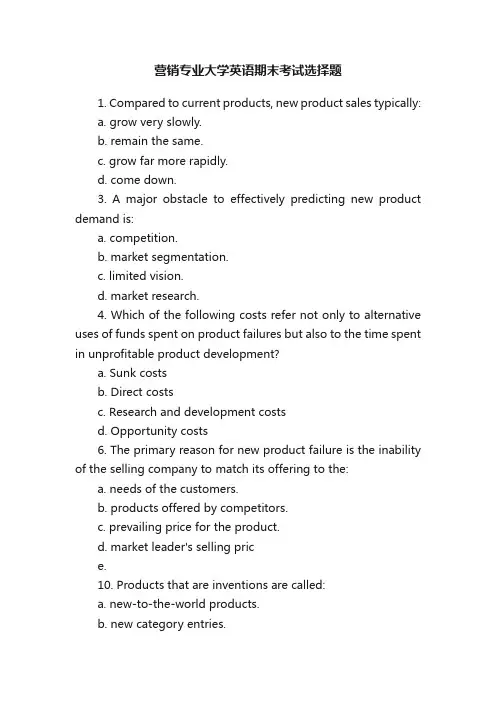
营销专业大学英语期末考试选择题1. Compared to current products, new product sales typically:a. grow very slowly.b. remain the same.c. grow far more rapidly.d. come down.3. A major obstacle to effectively predicting new product demand is:a. competition.b. market segmentation.c. limited vision.d. market research.4. Which of the following costs refer not only to alternative uses of funds spent on product failures but also to the time spent in unprofitable product development?a. Sunk costsb. Direct costsc. Research and development costsd. Opportunity costs6. The primary reason for new product failure is the inability of the selling company to match its offering to the:a. needs of the customers.b. products offered by competitors.c. prevailing price for the product.d. market leader's selling price.10. Products that are inventions are called:a. new-to-the-world products.b. new category entries.c. addition to product lines.d. product improvements.11. Products that take a firm into a product type new to it, but that are not new to the world are known as:a. new-to-the-world products.b. new category entries.c. additions to product lines.d. product improvements.15. A current product of a company has been enhanced to better serve consumer needs. The new product would fall into which of the following categories?a. New-to-the-world productsb. New category entriesc. Additions to product linesd. Product improvementsAnswer: dLearning Objective: 07-1Level of Difficulty: mediumBloom’s: ComprehensionAACSB: Reflective thinkingTopic: New Product StrategyPage: 99Explanation: Product improvements are current products made better. Virtually every product on the market has been improved, often many times.32. Which of the following strategies refers to creating new products to replace existing ones?a. Market penetrationb. Product developmentc. Market developmentd. Market diversificationAnswer: bLearning Objective: 07-1Level of Difficulty: EasyBloom’s: KnowledgeAACSB: AnalyticTopic: New Product StrategyPage: 99Explanation: Product development refers to creating new products to replace existing ones.73. Identify the two methods commonly used for creating and managing project teams.a. Idea screening and observational researchb. Test marketing and marketing applicationsc. Skunkworks and rugby approachd. Idea generation and consumer researchChapter 81. Positive images can create value for customers by adding:a. meaning to products.b. features to products.c. design elements to products.d. price details to products.2. Marketing communications designed to create awareness are especially important for new products and brands in order to:a. stimulate trial purchases.b. conduct marketing research.c. do successful vertical marketing.d. build channel relationships.3. Marketers create positive and distinct images through:a. test marketing.b. marketing communications.c. marketing research.d. vertical marketing.Answer: b4. _____ is becoming an important goal of marketing communications because modern technology makes information gathering more practical.a. Building positive imagesb. Retaining customersc. Building channel relationshipsd. Identifying prospects6. Retailers can support manufacturers by:a. featuring the manufacturer's brands in their ads.b. distributing coupons to them.c. setting prices exceptionally high.d. discouraging personal selling.13. This paid form of nonpersonal communications may use media such as outdoor displays, car cards, directories, etc., to reach out to a target audience.a. Direct marketingb. Advertisingc. Personal sellingd. Sales promotion14. Which of the following is a personal form of communication?a. Public relationsb. Advertisingc. Sales promotiond. Door-to-door selling21. This refers to a face-to-face communication withpotential buyers to inform them about and persuade them to buy an organization's products and services.a. Personal sellingb. Advertisingc. Sales promotiond. Online marketing34. Which of the following promotional tools is least likely to produce conviction among potential buyers?a. Sales promotionb. Personal sellingc. Advertisingd. Public relations65. Over the past two decades, the popularity of sales promotion has been increasing due to:a. the increased pressure on management for long-term results.b. the emergence of new purchase tracking technology.c. the decreasing number of independent retailers.d. a decline in product quality because of poor research and development.67. This involves aiming promotional efforts at distributors, retailers, and sales personnel to gain their cooperation in ordering, stocking, and accelerating the sales of a product.a. Pull marketingb. Push marketingc. Creative marketingd. Target marketing68. _____ involve(s) aiming promotional efforts directly at customers to encourage them to ask the retailer for the product.a. Pull strategiesb. Push strategiesc. Penetration pricingd. SkimmingChapter 91. Personal selling, unlike advertising or sales promotion, involves:a. customer inducements.b. direct relationship between buyer and seller.c. mass marketing.d. a non-personal medium.2. Behavioral scientists would most likely characterize _____ as a type of personal influence.a. personal sellingb. marketingc. distributiond. advertising4. The importance of the personal selling function depends partially on the nature of:a. advertising.b. mass marketing.c. public relations.d. the product.5. Which of the following would often need significant amounts of personal selling?a. Calculatorsb. Staplesc. Insuranced. Soft drinks7. Personal selling provides the push needed to get _____ to carry new products, increase their amount of goods purchased,and devote more effort in merchandising a product or brand.a. middlemenb. consumersc. staffd. employees8. _____ are in the best position to act as the intermediary, through whom valuable information can be passed back and forth between buyers and producers.a. Shareholdersb. Financiersc. Advertisersd. Salespeople12. One of the main tasks of the salesperson providing after-sale service is:a. delivery or installation of the product or service that meets or exceeds customer expectations.b. gathering information about prospects.c. selling additional or complementary items to repeat customers.d. converting undecided customers into first-time buyers.13. For many years, the traditional approach to selling emphasized the first-time sale of a product or service as the culmination of:a. gathering information about prospects.b. the sales process.c. learning about products to be sold.d. prospecting.14. _____ is the first stage in the sales relationship-building process.a. Gathering information about prospectsb. Planning the sales callc. Learning about the products to be soldd. Prospecting15. The traditional approach to selling views the initial sale ofa product or service as:a. merely the first step in a long-term relationship-building process.b. the culmination of the sales process.c. a long-term partnership mutually beneficial to both the buyer and seller.d. a relationship-building process and not the end goal.16. The process of locating potential customers is called:a. database building.b. cold calling.c. customer knowledge.d. prospecting.17. Prospecting is critical to the success of organizations in maintaining or increasing:a. advertising costs.b. quality.c. sales volumes.d. company image.18. In the sales relationship-building process, what is the step after planning the sales call?a. Responding to objectionsb. Presentingc. Obtaining commitmentd. Building a long-term relationship22. A potential prospect that may or may not have the potential to be a true prospect is known as a(n):a. lead.b. marketer.c. advertiser.d. financier.26. Once _____ are generated, the salesperson must determine whether the prospect is a true prospect.a. revenuesb. leadsc. primary datad. reportsChapter 101. The _____ provide(s) the ultimate consumer or organizational buyer with time, place and possession utility.a. marketing planb. strategic planc. channels of distributiond. marketing concept2. A _____ is the combination of institutions through which a seller markets products to the user.a. retailerb. distribution channelc. wholesalerd. logistics organization3. The primary role of all marketing intermediaries is to:a. bring supply and demand together in an efficient and orderly fashion.b. gather information from consumers in order to help manufactures design products better.c. produce goods and services efficiently to meet the demands of customers.d. perform different production functions for the manufacturers.4. The need for _____ in the delivery of goods is sometimes questioned, particularly since the profits they make are viewed as adding to the cost of the product.a. consumersb. intermediariesc. contract employeesd. wholesalers9. A(n) _____ is a middleman who buys from manufacturers and sells to retailers and wholesalers.a. facilitating agentb. distributorc. jobberd. agent10. ______ generally operates on an extended contractual basis, often sells within an exclusive territory, handles noncompeting but related lines of goods and possesses limited authority with regard to prices and terms of sale.a. A facilitating agentb. A competitorc. A jobberd. A manufacturer's agent12. Transactional functions performed by channels of distribution include buying, selling and:a. grading.b. assorting.c. marketing research.d. risk taking.14. _____ is a facilitating function of channels of distribution.a. Financingb. Buyingc. Sellingd. Transporting15. Providing information to customers and suppliers, including competitive conditions and trends belongs to which category of facilitating function?a. Financing and gradingb. Marketing information and researchc. Assortingd. Risk taking16. In transactional functions of channels of distribution, contacting potential customers, promoting products and soliciting orders is concerned with:a. buying.b. assorting.c. selling.d. sorting.22. _____ is a merchant middleman who is engaged primarily in selling to ultimate consumers.a. Facilitating agentb. Jobberc. Agentd. Retailer24. One of the reasons why the direct channel is often used in the distribution of organizational goods is that:a. their pricing plans to achieve a target return of investment require direct channels of distribution.b. there is a lack of stabilization of price and margin.c. a number of intermediaries are required for their sales.d. they need a great deal of presale and postsale services.28. A cold remedy manufacturer sells drug to wholesalers who, in turn, sell a vast array of drug products to various retail outlets. Identify the type of channel used by cold remedy manufacturer.a. Direct channelb. Indirect channelc. Peer to peer marketingd. Indirect marketing30. As in the consumer markets, _____ are used in organizational markets when manufacturers do not wish to have their own sales force.a. wholesalersb. plannersc. agentsd. producers32. In the early stages of _____, executives map out elaborate channel networks only to find out later that no independent intermediaries exist for the firm's product in the geographic region.a. consumer researchb. product planningc. channel designd. mission statement development33. For a particular product, any one amongst the customer, product, intermediary, competitor, company or environmental characteristics may greatly influence the:a. raw materials needed.b. choice of channel.c. amount of service.d. vertical market.Chapter 111. _____ on pricing decisions concern primarily the nature of the target market and expected reactions of consumers to a given price or change in price.a. Government influencesb. Environmental influencesc. Supply influencesd. Demand influences3. Which of the following factors related to pricing is concerned primarily with how consumers perceive various prices or price changes?a. Environmentalb. Psychologicalc. Demographicd. Sociological4. The three primary considerations pertaining to demand influences for a product are:a. segmentation variables used, breakeven point, and required discounts.b. internal rate-of-return, target pricing, and cost-plus pricing.c. required discounts, price elasticity, and breakeven point.d. demographic factors, psychological factors, and price elasticity.7. If consumers or organizational buyers perceive the price of a product to be too low, then:a. customers judge the product quality to be the best.b. the firm will make huge profit.c. it would help in brand building for the firm.d. sales might increase but profitability may suffer.14. Research has tentatively established that customers who choose high-priced items see the consequences of a poor choice as being undesirable as they:a. perceive large quality variations within product categories.b. are usually insensitive to the value of prestige products.c. are highly sensitive to changes in price.d. incur no benefits from any pricing strategies aimed at other consumers.25. Prestige pricing, odd pricing and _____ are three types of psychological pricing strategies.a. portfolio pricingb. price skimmingc. bundle pricingd. reference pricing26. Price elasticity is a measure of consumer's price sensitivity, which is estimated by dividing relative changes in the quantity sold by the:a. volume consumed.b. cost of the product or service.c. relative quantity produced.d. relative changes in price.35. Research has found that the most common pricing objectives are pricing to achieve a target return of investment, stabilization of price and margin, pricing to meet or prevent competition and pricing:a. in accordance with policies and procedures.b. to eliminate purchasing roles.c. to achieve a target market share.d. to increase personal selling.36. The three basic variations in cost-oriented pricing are mark-up pricing, cost-plus pricing, and:a. odd pricing.b. bundle pricing.c. rate-of-return pricing.d. prestige pricing.49. Which of the following is a product consideration in pricing?a. Affordabilityb. Distinctivenessc. Target return on investmentd. Target market share55. Manufactured goods can be differentiated on the basis of certain features, such as package, trademark, engineering design, and chemical features. These features highlight the _____ of the product.a. distinctivenessb. perishabilityc. life cycled. intangibility69. _____ is an example of pricing below the competition.a. Cost-minus pricingb. Bundle pricingc. Skimming pricingd. Sealed-bid pricingChapter 121. Over the course of the past 40 years, the fastest growingsegment of the American economy has been thea. independent management of major accounts.b. production of tangible products.c. performance of services.d. merger and acquisition of businesses.5. Service products such as bank loans or home security are _____ and often difficult to identify since they come into existence at the same time they are bought and consumed.a. tangibleb. intangiblec. non-existentd. substantial10. Service products are often difficult to identify, since theya. can be sold in the sense of ownership transfer.b. are bought and consumed at the same time.c. are tangible elements and cannot be easily transferred.d. cannot be exchanged directly from producer to user.14. (p. 176) Service characteristics like intangibility, inseparability, perishability etc. often have a significant impact ona. tracking customer grievances.b. production design and development.C. marketing program development.d. the research and development technology.15. Depending on the type of service, the _____ may dictate use of direct channels because of the need for personal contact between the buyer and seller.a. perishability factorb. intangibility factorc. uniformity factord. inseparability factor16. The obvious basic difference between goods and services is the _____ of servicesa. imperishabilityB. intangibilityc. separabilityd. palpability26. In many cases, a service cannot be separated from the person of the seller because the service must be produced and marketed simultaneously. This simultaneous production and marketing makes creation of_____ the main concern of the marketer.a. time and place utilityb. circuitous channels of distributionc. storage spaced. variation in quality29. Due to their inseparability, servicesa. are typically marketed through indirect channels of distribution.b. can be inventoried.c. are produced and consumed simultaneously.d. create form utility.35. Discounts given for weekend calling, Saturday night stay-overs, early-bird dinners or winter cruises are all examples of efforts made by service providers to redistribute demand and best describea. off-peak pricing.b. odd pricing.c. rate of return pricing.d. markup pricing.34. In marketing services, a _____, as opposed to a customer relationship, exists between the buyer and seller.a. dealer relationshipb. partner relationshipc. client relationshipd. supplier relationship这是英语期末考试的选择题,上课时老师讲解的答案,我已经用红色字体做了标注,后面15题老师没讲,答案是我自己在书上找的,可能会有主观上的错误,大家看的时候可以再对照自己的答案。
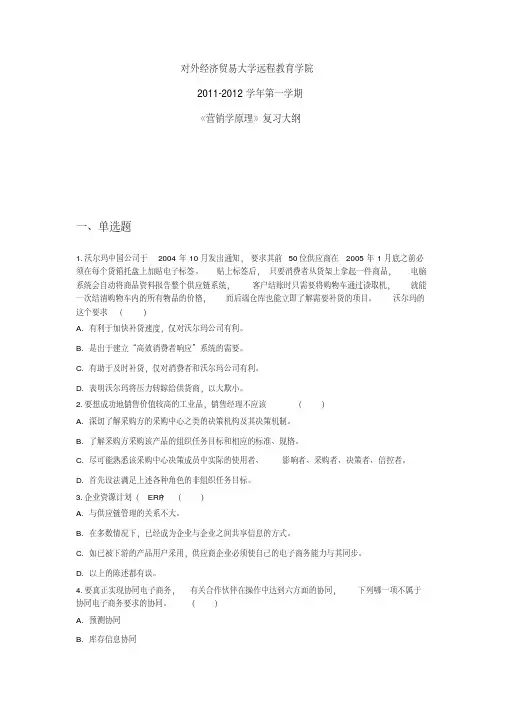
对外经济贸易大学远程教育学院2011-2012学年第一学期《营销学原理》复习大纲一、单选题1.沃尔玛中国公司于2004年10月发出通知,要求其前50位供应商在2005年1月底之前必须在每个货箱托盘上加贴电子标签。
贴上标签后,只要消费者从货架上拿起一件商品,电脑系统会自动将商品资料报告整个供应链系统,客户结账时只需要将购物车通过读取机,就能一次结清购物车内的所有物品的价格,而后端仓库也能立即了解需要补货的项目。
沃尔玛的这个要求()A. 有利于加快补货速度,仅对沃尔玛公司有利。
B. 是出于建立“高效消费者响应”系统的需要。
C. 有助于及时补货,仅对消费者和沃尔玛公司有利。
D. 表明沃尔玛将压力转嫁给供货商,以大欺小。
2.要想成功地销售价值较高的工业品,销售经理不应该()A. 深切了解采购方的采购中心之类的决策机构及其决策机制。
B. 了解采购方采购该产品的组织任务目标和相应的标准、规格。
C. 尽可能熟悉该采购中心决策成员中实际的使用者、影响者、采购者、决策者、信控者。
D. 首先设法满足上述各种角色的非组织任务目标。
3.企业资源计划(ERP)()A. 与供应链管理的关系不大。
B. 在多数情况下,已经成为企业与企业之间共享信息的方式。
C. 如已被下游的产品用户采用,供应商企业必须使自己的电子商务能力与其同步。
D. 以上的陈述都有误。
4.要真正实现协同电子商务,有关合作伙伴在操作中达到六方面的协同,下列哪一项不属于协同电子商务要求的协同。
()A. 预测协同B. 库存信息协同C. 采购计划协同D. 采购订单的执行协同E. 客户名录等信息的协同5.以下有关组织市场和消费品市场区别的陈述中,哪一条是正确的?()A. 组织市场的购买人数多于消费品市场的购买人数。
B. 许多工业品的总需求不怎么受价格变动的影响。
C. 组织市场的需求不像消费品市场的需求那样容易波动。
D. 以上三条都正确。
6.当刘波看着自己那高高的四驱多用途跑车时,他感到自己的能力、地位和潇洒;而在她母亲眼里,这辆车马力大,太费油,速度快,不安全,令人担忧。
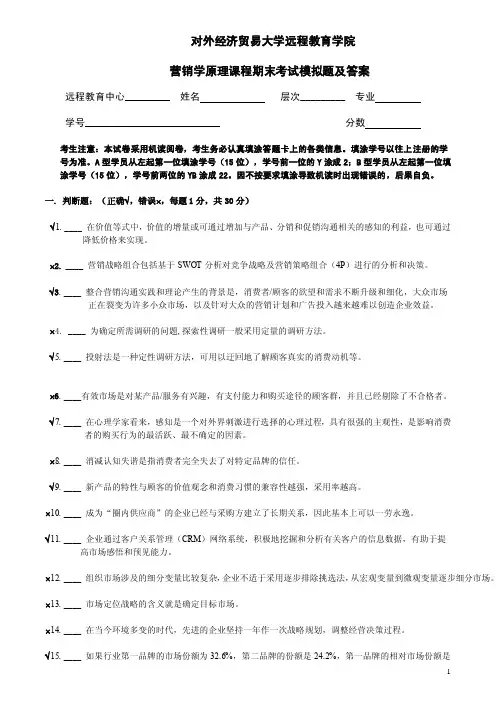
对外经济贸易大学远程教育学院营销学原理课程期末考试模拟题及答案远程教育中心_________ 姓名层次_________ 专业学号___________________________ 分数考生注意:本试卷采用机读阅卷,考生务必认真填涂答题卡上的各类信息。
填涂学号以往上注册的学号为准。
A型学员从左起第一位填涂学号(15位),学号前一位的Y涂成2;B型学员从左起第一位填涂学号(15位),学号前两位的YB涂成22。
因不按要求填涂导致机读时出现错误的,后果自负。
一. 判断题:(正确√,错误⨯,每题1分,共30分)√1. ____ 在价值等式中,价值的增量或可通过增加与产品、分销和促销沟通相关的感知的利益,也可通过降低价格来实现。
⨯2. ____ 营销战略组合包括基于SWOT分析对竞争战略及营销策略组合(4P)进行的分析和决策。
√3. ____ 整合营销沟通实践和理论产生的背景是,消费者/顾客的欲望和需求不断升级和细化,大众市场正在裂变为许多小众市场,以及针对大众的营销计划和广告投入越来越难以创造企业效益。
⨯4. ____ 为确定所需调研的问题,探索性调研一般采用定量的调研方法。
√5. ____ 投射法是一种定性调研方法,可用以迂回地了解顾客真实的消费动机等。
⨯6. ____有效市场是对某产品/服务有兴趣,有支付能力和购买途径的顾客群,并且已经剔除了不合格者。
√7. ____ 在心理学家看来,感知是一个对外界刺激进行选择的心理过程,具有很强的主观性,是影响消费者的购买行为的最活跃、最不确定的因素。
⨯8. ____ 消减认知失谐是指消费者完全失去了对特定品牌的信任。
√9. ____ 新产品的特性与顾客的价值观念和消费习惯的兼容性越强,采用率越高。
⨯10. ____ 成为“圈内供应商”的企业已经与采购方建立了长期关系,因此基本上可以一劳永逸。
√11. ____ 企业通过客户关系管理(CRM)网络系统,积极地挖掘和分析有关客户的信息数据,有助于提高市场感悟和预见能力。
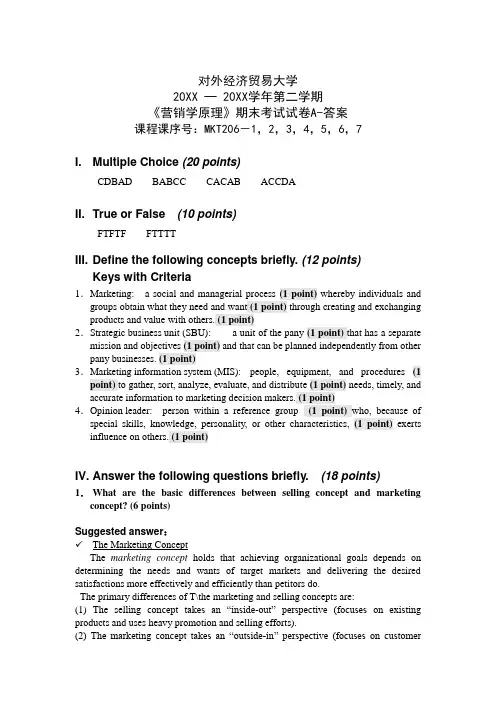
对外经济贸易大学20XX ─ 20XX学年第二学期《营销学原理》期末考试试卷A-答案课程课序号:MKT206-1,2,3,4,5,6,7I. Multiple Choice (20 points)CDBAD BABCC CACAB ACCDAII. True or False (10 points)FTFTF FTTTTIII. Define the following concepts briefly. (12 points) Keys with Criteria1.Marketing: a social and managerial process (1 point) whereby individuals and groups obtain what they need and want (1 point) through creating and exchanging products and value with others. (1 point)2.Strategic business unit (SBU): a unit of the pany (1 point) that has a separate mission and objectives (1 point) and that can be planned independently from other pany businesses. (1 point)3.Marketing information system (MIS): people, equipment, and procedures (1 point) to gather, sort, analyze, evaluate, and distribute (1 point) needs, timely, and accurate information to marketing decision makers. (1 point)4.Opinion leader: person within a reference group (1 point) who, because of special skills, knowledge, personality, or other characteristics, (1 point)exerts influence on others. (1 point)IV. A nswer the following questions briefly. (18 points) 1.What are the basic differences between selling concept and marketing concept? (6 points)Suggested answer:✓The Marketing ConceptThe marketing concept holds that achieving organizational goals depends on determining the needs and wants of target markets and delivering the desired satisfactions more effectively and efficiently than petitors do.The primary differences of T\the marketing and selling concepts are:(1) The sel ling concept takes an “inside-out” perspective (focuses on existing products and uses heavy promotion and selling efforts).(2) The marketing concept takes an “outside-in” perspective (focuses on customerneeds, values, and satisfactions).✓The Selling ConceptThe selling concept is the idea that consumers will not buy enough of the organization’s products unless the organization undertakes a large-scale selling and promotion effort.This concept is typically practiced with unsought goods.Criteria:(1)2 points for illustration of the Marketing Concept and Selling Concept;(2)2 points for the parison of pany’s different perspectives guided by differentconcepts.(3)2 points for the parison of pany’s different focuses guided by different concepts. 2.Describe the kinds of horizontal (横向)and vertical (纵向)channel conflict that might occur in the automobile industry? (6 points)Suggested Answer:Disagreement in goals and roles generate channel conflict. Horizontal conflict occurs among firms at the same level of the channel. This could occur when one set of dealers steps outside an assigned territory base and “steals” customers from another dealer group. This might occur because of aggressive pricing and advertising strategies. Vertical conflict occurs between different levels of the same channel. This form is more mon than horizontal conflict. If a producer or manufacturer decides to expand distribution outlets or opens an “online store” it often es in conflict with existing dealers who feel threatened by expansion plans.In the automobile industry, horizontal conflict (dealers representing the same manufacturer violate territories and aggressively pete against other licensed dealers)--an automobile manufacturer decides to open its own set of retail stores (vertical conflict).Criteria:(1) 1 point for the definition of channel conflict;(2) 1 point for the parison of horizontal conflict and vertical conflict;(3) 2 point for the definition of horizontal conflict and possible cases;(4) 2 point for the parison of vertical conflict and possible cases.3.Classify and explain the advertising objectives by its primary purpose. (6 points)Suggested Answer:Advertising objectives can be classified by primary purpose as:1). Informative advertising: which is advertising used to inform consumers abouta new product or feature or to build primary demand.2). Persuasive advertising: which is advertising used to build selective demand fora brand by persuading consumers that it offers the best quality for their money.3). parison advertising:which is advertising that pares one brand directly or indirectly to one or more other brands.4). Reminder advertising:which is advertising used to keep consumers thinking about a product. This form of advertising is more important for mature products. Criteria:1.5 points for each primary purpose.V. Case Analysis (40 points)1. (20 points)(1) Suppose the manufacturer wants to breakeven, that is, for total revenue tocover total cost, at least how many units of the phone must be sold at this price? (7 points)Suggested answers & Criteria:$1,000,000 / ($100 - $50) (4 points) = $1,000,000 / $50 =20,000 (units)(the right result, 3 points)(2) Calculate the total revenue at the breakeven point. (6 points)Suggested answers & Criteria:20,000 * $100 (4 points) = $2,000,000 (the right result, 2 point)(3) If the manufacture wants to make a target profit of $500,000, how many unitsof the phone must be sold at this price? (7 points)Suggested answers & Criteria:($1,000,000 + $500,000) / ($100 - $50) (4 points) = $1,500,000 / $50 =30,000 (units)(the right result, 3 points)2. Product Mix of Unilever China (20 points)1) Define the width, length, and consistency of a product mix. Describe the product mix of Unilever China in terms of width, length, and consistency. (9 points)Suggested answer:✓Product mix width refers to the number of different product lines the pany carries.(1 point) The mix width of Unilever China is 9: Hair Care, Skin Care, PersonalCleaning, Oral Care, Ice Cream, Tea, Savory, Spreads & Dressings and Laundry.(2 points)✓Product mix length refers to the total number of items the pany carries within its product lines. (1 point) Unilever China sells 2 Hair Care brands, 4 Skin Carebrands, 2 Personal Cleaning brands, 2 Oral Care brand, 1 Ice Cream, 2 Teas, 2 Savories, 2 Spreads & Dressings and 2 Laundry brands. (2 points)✓Product mix consistency refers to how closely related the various product lines are in end use, production requirements, distribution channels, or some other way.(1 point) Laundry products and oral/skin/beauty care items of Unilever China areconsistent insofar as they are consumer goods that go through the samedistribution channels and perform the similar functions for buyers. But food and beverage items (Ice Cream, Tea, Savory and Spreads & Dressings) are lessconsistent. (2 points)Criteria:a. 1 point for the definition of product mix width, 2 points for the product mix widthof Unilever China;b 1 point for the definition of product mix length, 2 points for the product mix lengthof Unilever China;c. 1 point for the definition of product mix consistency, 2 points for the product mixconsistency of Unilever China.2) What brand strategy (line extensions, brand extensions, multibrands or new brands) does Unilever apply to its Skin Care line? Explain the strength and weakness of such brand strategy. (11 points)Suggested answer:✓The brand strategy that Unilever applies to its Skin Care category is multibrands,(2 points) because it markets 4 different brands in it. (2 points)✓Strength of multibranding: It offers a way to establish different features and appeal to different buying motives. It allows Unilever to look up more reseller shelf space. Unilever may use fighter/flanker brands to protect its major brands.Unilever may develop separate brands for different regions and countries. (4points)✓Drawbacks of multibranding: Each brand might obtain only a small market share, and one maybe very profitable. petition among these brands is hard to be avoided.Marketing expenditures (such as advertising budget) maybe extremely high. (3 points)Criteria:a.2 points for the judgment of Unilever brand strategy; 2 points for the argumentsraised;b.4 points for the strengths of multibranding, 1 point for possible strength, maximum 4 points;c.3 points for the weaknesses of multibranding, 1 point for possible weakness, maximum 3 points.-- End --。
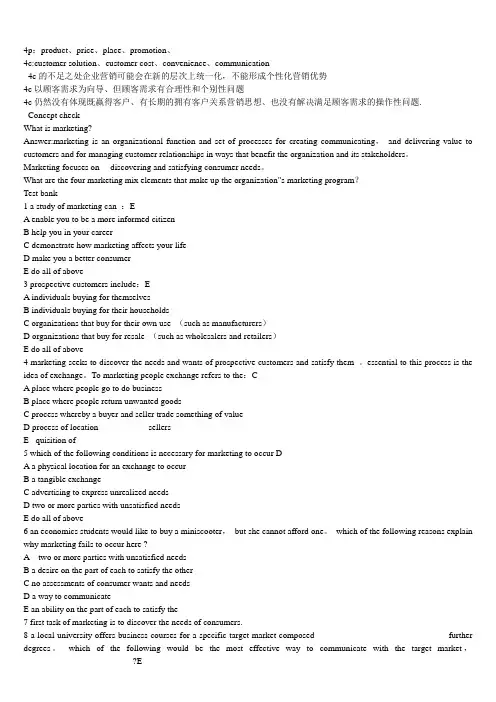
4p:product、price、place、promotion、4c:customer solution、customer cost、convenience、communication4c的不足之处企业营销可能会在新的层次上统一化,不能形成个性化营销优势4c以顾客需求为向导、但顾客需求有合理性和个别性问题4c仍然没有体现既赢得客户、有长期的拥有客户关系营销思想、也没有解决满足顾客需求的操作性问题.Concept checkWhat is marketing?Answer:marketing is an organizational function and set of processes for creating communicating,and delivering value to customers and for managing customer relationships in ways that benefit the organization and its stakeholders。
Marketing focuses on __discovering and satisfying consumer needs。
What are the four marketing mix elements that make up the organization"s marketing program?Test bank1 a study of marketing can :EA enable you to be a more informed citizenB help you in your careerC demonstrate how marketing affects your lifeD make you a better consumerE do all of above3 prospective customers include:EA individuals buying for themselvesB individuals buying for their householdsC organizations that buy for their own use (such as manufacturers)D organizations that buy for resale (such as wholesalers and retailers)E do all of above4 marketing seeks to discover the needs and wants of prospective customers and satisfy them 。
《营销学原理》课程同步练习参考答案第一章市场营销概论一、填空题。
1、交换是市场营销活动的核心。
2、根据科特勒的定义,市场营销是个人和群体通过创造以及同其他个人和群体交换产品和价值而满足欲望和需求的一种社会和管理的过程。
3、“以产定销”反映的是一种生产观念。
4、市场营销的4C组合是指成本、顾客需求和欲望、沟通、以及便利。
5、需求必须有两个条件,即购买愿望、购买力6、市场营销的4R组合是指关联、反应、关系、回报二、选择题。
以下问题各自只有一个正确答案,请选出。
1、“酒香不怕巷子深”的说法反映了 B 。
A.生产观念B.产品观念C.营销观念D.销售观念2、对于潜在需求,我们一般进行 C 。
A.再生性营销B.刺激性营销C.发展性营销D.转换性营销3、对于否定的需求,营销的任务是( A )A、解释需求B、发展需求C、保持需求D、减少需求4、对于不规则需求产品,我们一般应采取( D )A 发展性营销B 转换性营销C 刺激性营销D 同步性营销三、判断题。
判断各问题的表述对错,对有错的题干进行修改。
1、市场营销学中,产品指能够提供给市场交换,用来满足顾客需求和欲望的有形产品答:错。
产品必须能满足顾客的需求,才能实现交换。
2、产品是被卖出去的,决定产口销量的是销售人员的能力答:错。
决定产品销量的关键还是产品是否满足目标顾客的需求,及能否带给顾客较好的价值。
3、“以产定销”的企业把提高效率和产量、降低成本和价格作为一切活动的中心。
四、简答题。
1、试举例说明什么是销售观念?答:举例略。
销售观念指企业维持生产已不受市场欢迎的产品,在此基础上强行推销,把强迫和引诱顾客购买作为一切活动的中心,以此扩大销售、取得利润的经营指导思想。
2、市场营销的4P组合是什么?答:产品、价格、分销和促销3、为什么我们要提倡社会营销观念?答:社会营销观念考虑的是在为企业取得利益的同时,兼顾顾客的眼前利益、个人利益、长远利益和社会整体利益。
五、论述题。
2021市场营销学卷子真题和答案〔一〕市场营销学卷子〔一〕一、单项选择题〔本大题共30小题,每题1分,共30分〕1、在冬季,一些亚麻凉席生产企业开展打折促销活动,出现了淡季热销的局面。
这是因为亚麻凉席的需求属于【】A.无需求B.下降需求C.不规则需求D.充分需求2、市场营销观念强调注重【】A.供应商需求B.消费者需求C.卖方需求D.零售商需求3、科特勒提出的“大市场营销〞组合构成是【】A.2PB.4PC.5PD.6P4、绿源公司原为一家有机蔬菜种植企业,后收购一家蔬菜零售连锁店进入销售领域。
这种一体化增长方法属于【】A.水平一体化B.前向一体化C.后向一体化D.同向一体化5、五星公司针对新月公司的产品,采取了“我也是〔Me too〕〞战略,这种定点超越战略也被称为【】A.产品定点超越B.组织定点超越C.过程定点超越D.战略定点超越6、为了解消费者对不同口味月饼的喜好,禾香公司特意在街头对顾客进行随机访问,这种数据搜集方法为【】A.观察法B.专家评估法C.设计法D.调查法7、丽兰化装品公司决定对其现有市场上销售的润肤霜进行升级换代,这种密集增长战略是【】A.市场渗透B.产品开发C.市场开发D.多元化开展8、某洗衣机制造商在顾客购置其生产的洗衣机后,主动与顾客联系,征求顾客的意见,这在关系营销中属于【】A.负责型关系营销B.煽动型关系营销C.伙伴型关系营销D.根本型关系营销9、国家节能减排政策对生产高耗能产品的企业来说是【】A.营销时机B.环境威胁C.冒险时机D.消费者威胁10、用于购置食品的支出占家庭总收入比例下降,意味着【】A.恩格尔系数增大B.基尼系数减小C.恩格尔系数变小D.基尼系数增加11、小王每周去超市购置同一品牌、规格的牛奶供家庭饮用,这种购置行为类型是【】A.复杂型购置行为B.变换型购置行为C.协调型购置行为D.习惯型购置行为12、某银行购进了一批自动存取款机。
从组织市场的构成来说,属于【】A.产业市场B.消费者市场C.中间商市场D.政府市场13、某皮鞋生产企业决定增加运动鞋生产车间并购进了相应设备。
营销学原理第一章——第三章练习答案一、单项选择1.需求是()A. 没有得到某些基本满足的感受状态B. 想得到基本需要的具体满足物的愿望C. 对于有能力购买并且愿意购买的某个具体产品的欲望D. 对于愿意购买的某个具体产品的欲望2.福特汽车公司在本世纪初曾倾全力于汽车的大规模生产,努力降低成本,使消费者买得起,这种经营思想属于()A. 产品观念B.生产观念 C .推销观念 D .市场营销观念3. “生产出好产品卖给顾客”这句话反映的是A. 推销观念B. 市场营销观念C.产品观念D.生产观念4. 指出下哪种观念最容易产生“营销近视症”A.产品观念B .推销观念 C.市场营销观念D .社会市场营销观念5. ()要求市场营销者在制定市场营销政策时,要兼顾企业利益、消费者需要、社会利益等三方面的利益。
A. 市场营销观念B. 生产观念C. 推销观念D. 社会营销观念6. 产品观念强调的是()A以量取胜B、以廉取胜C、以质取胜D、以形象取胜7. 市场营销观念的中心是()A.推销已经生产出来的产品B.发现需要并设法满足他们C.制造质优价廉的产品 D .制造大量产品并推销出去。
8. 市场是指对某项商品或劳务具有需求的所有A. 个人消费者B. 生产者C. 机构集团D. 现实与潜在买者9. 市场营销的核心是A. 交换活动B. 销售活动C. 生产活动D. 促销活动10. 生产家用电器的企业与房地产公司是()。
A. 愿望竞争者B. 平行竞争者C. 品牌竞争者D. 产品形式竞争者11. “捷安特”自行车公司是“桑塔纳”轿车生产厂的A. 愿望竞争者B. 平行竞争者C. 产品形式竞争者D. 品牌竞争者12. 企业在调整业务投资组合时,对某些问号类业务单位,欲使其转入明星类单位,宜采取哪种战略()A 维持B 收获C 发展增大D 放弃13. 金牛类战略业务单位适合的战略选择是()A.发展增大B.维持C .收获D .放弃14. 市场营销组合是指()A.对企业各种环境因素的组合 B .对企业宏观环境因素的组合C.对影响价格因素的组合 D .对企业可控的各种营销因素的组合15. 许多冰箱生产厂家近年来高举“环保”、“健康”旗帜,纷纷推出无氟冰箱。
《营销学原理》试卷1一、单项选择题(在每小题备选的四个答案中选择一个最合适的,并将选中答案的字母填在题干前面的括号内。
每小题1分,共12分。
)()1.市场营销的核心是_________。
A.生产B.分配C.交换D.促销()2.一般日用生活用品,适合于选择_________媒介做广告。
A.人员B.专业杂志C.电视D.公共关系()3._________是指企业利用多种信息载体,与目标市场进行沟通的传播活动,包括广告、人员推销、营业推广与公共关系等等。
A.产品B.定价C.促销D.分销()4.消费者的购买单位是个人或_________。
A.集体B.家庭C.社会D.单位()5.从购买行为来看,专业购买、不易受感情因素影响的这类市场称为()A.消费者市场B.生产者市场C.日用品市场D.选购品市场()6._________主要指协助企业促销、销售和经销其产品给最终购买者的机构。
A.供应商B.制造商C.中间商D.广告商()7.在产品生命周期的投入期,消费品的促销目标主要是宣传介绍产品,刺激购买欲望的产生,因而主要应采用_________促销方式。
A.广告B.人员推销C.价格折扣D.营业推广()8._________差异的存在是市场细分的客观依据。
A.产品B.价格C.需求偏好D.细分()9.属于产业市场细分标准的是_________。
A.职业B.生活格调C.收入D.顾客购买规模()10.威胁水平高而机会水平低的业务是_________。
A.理想业务B.冒险业务C.成熟业务D.困难业务()11.为鼓励顾客购买更多物品,企业给那些大量购买产品的顾客的一种减价称为_________。
A.功能折扣B.数量折扣C.季节折扣D.现金折扣()12.向最终消费者直接销售产品和服务,用于个人及非商业性用途的活动属于_________。
A.零售B.批发C.代理D.直销二、多项选择题(在每小题的五个备选答案中至少有两个是正确的,请选出所有正确的答案,并把答案的字母填在题干前面的括号内。
对外经济贸易大学2001⎯2002学年第二学期《营销学原理》期末考试试卷A00营销、99海关、99商检、99法律、99行政、00财务、00会本、00信息、99留学生、00金融学号__________ 姓名__________班级__________ 成绩__________I. Multiple Choice (only one answer is correct, 30 points):1. Marketing is best understood as the process of:A. making a sale.B. creating customer needs.C. satisfying customer needs and wants.D. promoting products and services.E. generating (产生) a profit.2. A person's want becomes a demand when his want is backed (支持) byA. purchasing power.B. products.C. needs.D. desire.E. exchange mechanisms.3. The __________ concept holds that all consumers will favor (喜欢) those products offering the most quality performances and features, therefore, the organization should devote its energy to makingcontinuous product improvements.A. productionB. productC. serviceD. marketingE. selling4. Leander Cosmetics is attempting to generate additional sales of its present products by promoting them more aggressively to its present customers. Leander Cosmetics is engaged in:A. diversificationB. market penetrationC. market developmentD. product development5. High growth, high share businesses or products appear in the Boston consulting group growth-share matrix as:A. dogsB. cash cows.C. question marks.D. stars.6. Which of the following is not a component (组成部分) of a company's microenvironment?A. marketing intermediariesB. customersC. competitorsD. economic environmentE. publics7. Organizations that buy goods and services for their production process in order to make profits are called__________ markets.A. resellerB. industrialC. internationalD. governmentE. consumer8. Positioning is used mainly toA. make communication easierB. make possible the product can be highly pricedC. obtain differentiated advantage in a competitive environmentD. increase the brand image9. The depth of a product mix refers toA. how many different product lines the company carriesB.how many variants are offered of each product item in the lineC.how closely related the various product lines are in end use, production requirementsor distribution channelsD.the total number of items in the product mix10. After the sale, marketing communications providing evidence and support to helpconsumers feel good about their brand choice is especially appropriate under which of the following situation?A. dissonance-reduction behaviorB. habitual buying behaviorC. complex buying behaviorD. variety-seeking behavior11.Business demand ultimately comes from the demand for consumer goods. This is known as_________ demand.A. latentB. fullC. derivedD. wholesomeE. negative12. Accessibility, as a requirement for effective segmentation, refers to the degree to whichA. the segments can be effectively reached and served.B. the segments are large and profitable enough.C. an effective program can be formulated for attracting and serving the segments.D. the size and purchasing power of the segments can be measured.E. the individuals making up the market segment can be identified and studied.13. A good package mayA. protect the product.B. promote the product.C. lower total distribution costs.D. all of the above14. Under the same product line, P&G launched various products carrying different brandnames. This strategy is called _________.A. brand extensionB. multiple brandsC. unique brandD. new brand15. Which of the following is typically not considered a reason why new products fail?A.The idea for the product is good, but the market has been underestimated (低估).B. A product has been incorrectly positioned in a market.C.Top management pushes through a favourite idea in spite of negative market research findings.D.Unexpected competition is encountered (遭遇).16. Simulated test marketingA. takes longer time to complete than standard test marketing.B. is much more expensive than controlled test marketing.C. does not allow competitors to get a look at the companies’ new product.D. is best used at trade shows.17. Product __________ is a period of rapid market acceptance and increasing profits.A. developmentB. introductionC. growthD. maturityE. decline18. If demand is elastic rather than inelastic and the firm is interested in increasing totalrevenue, the firm should:A. not change the price.B. decrease production.C. raise the price.D. lower the price.E. decrease promotional efforts.19. A market skimming pricing policy:A. starts with a high price which is gradually lowered (降低).B. starts with a high price and keeps it high.C. starts with a low price and gradually raises it.D. starts with a low price and keeps it low.20. Kevin Stiles is a farmer who sells his product directly to a supermarket chain which in turnsells it to customers. This is an example of _______marketing channel system.A. zero-lengthB. one-levelC. two-levelD. direct-levelE. sub-level21. Christine Robert, a fashion designer and producer of women' fashions, sells her fashionsthrough her own chain of boutiques (retail outlets, 小零售店). Christine Robert as the producer and retailer is an example of :A. franchise organization.B. corporate VMSC. administered VMSD. contractual VMSE. conventional VMS22. A________ strategy means a producer directs its marketing activities (primarily personalselling and trade promotion) toward channel members to induce them to carry the product and to promote it to final consumers.hard-sellA.B.pushC. soft-sellD. pull23. In the introduction stage of the product life cycle of a consumer good,A. personal selling is emphasized over advertising.B. advertising and publicity are cost effective in producing high awareness.C. sales promotion does not exist.D. publicity does not exist.E. advertising and public relations loses effectiveness rapidly.24. Many analysts believe that _______ activities do not build long-term consumer preferenceand loyalty as does _______.A.advertising, personal sellingB.public relations, sales promotionC.sales promotion, personal sellingD.sales promotion, advertising25. One Hi-Fi (高保真音响)maker divides the Hi-fi consumers into three types: type A is“musicians”, who buy Hi-Fi in order to enjoy music; type B is “technicians”, who are more interested in studying high technology; type C is “snobs”, who are more concerned by the status and richness marked by possessing Hi-Fi. This maker takes type A and B as its target market, because it thinks these two types of consumers are more inclined to buy this brand.The criterion (标准) used in market segmentation here isA.benefits soughtB.personalityC.life styleD.preference26. In the above case, the market-coverage strategy used by the manufacture is:A.concentrated marketingB.differentiated marketingC.undifferentiated marketingD.mass marketing27. If the fixed cost of a product is $ 4 000 000, the variable cost is $240 and the expected sales is50 000 units, suppose the manufacture wants a 20% markup on sales, the price should beA. $ 1 600B. $ 320C. $ 180D. $ 40028. In an attempt to build a unique product image to increase profits and exercise an effectivecontrol over the middleman, the manufacturers of upscale women’s apparels and of new luxurious cars tend to take which of the following strategy of distribution width?A.intensive distributionB.selective distributionC.exclusive distributionprehensive distribution29. Concerning quality management of one manufacturing company, which statement istrue?A.The quality standards should be determined by the company’s capability.B.It involves not only the product quality, but also the process quality.C.The goal of quality management is to minimize defective products (不合格产品).D.Historically, quality management always observes (遵守) the same principlesconsistently.30. The following statements about new product development are correct exceptA.The new product development is a step-by-step process.B.The new product development should be backed by an organizational innovation.C.The new product development does not always involve breakthrough technologicalinnovation.D.The new product development should be based upon the basic research findings (基础研究成果).II. True or False (20 points):_____ 1. In a seller’s market, sellers have more power; therefore, buyers have to be more active “marketers”._____ 2. New technology is typically a force for creative destruction, which may mean that the new technology hurts the old technology._____ 3. The buyer decision process began long before the purchase is made and ends when the purchase is actually made._____ 4. Once a product has begun its life cycle, typically a firm can do little to extend it._____ 5. Dell’s success is mainly due to its excellent supply chain management and logistics system._____ 6. Profit is usually negative during the product introduction stage of the product life cycle._____ 7. Line extension involves higher investment and risk compared to brand extension._____ 8. A buyer would probably travel a considerable distance to purchase a convenience good._____ 9. People tend to interpret incoming information in a way that will support what theyalready believe._____10. Concentrated marketing means that one company target only one market segment. _____ 11. Intensive distribution means a big number of middlemen are used._____ 12. Franchises are corporations that combine several different retailing forms under central ownership and share some distribution and management functions with thefranchisees._____13. Of the methods used in setting the promotion budget, only the objective-and-task method makes logical sense._____ 14. A market segment consists of consumers who respond in a similar way to a given set of marketing stimuli.____ 15. Attractively priced options packages for cars are examples of product-bundle pricing.____ 16. Changes in consumer taste may alter the shape of the product life cycle.____ 17. If a product is positioned on nonprice factors, then decisions about quality, promotion, and distribution will strongly affect price.____ 18. Quantity discounts are usually provided as a reward for paying bills promptly.____ 19. Wholesalers and retailers both must make marketing decisions about target markets, product assortments and services, price, promotion, and place.____ 20. The growth in technologically complex products has extended the length of sales training programs.III. Calculate the following (20 points):1.Wilderson’s company markets vacuum cleaners. Its costs and expected sales areas follows:Fixed cost $2,960,000Variable cost $1,840,000Expected Unit Sales 150,000Suppose Wilderson’s wants to earn a 25% markup on the sales, what should the unit price be then? (5 points)2. Suppose a machine tool company sold 3,600 machine tools this year and wants topredict next year’s July sales. The long-term trend shows a 7% sales growth rate per year. However, a business recession is expected next year and probably will result in total sales achieving only 90 percent of the expected trend- adjusted sales. July is a below-average month for machine tool sales, with a seasonal index standing at 0.80. The company expects no erratic events.How many machine tools will the company expect to sell in July next year? (5 points)3. Mrs. Zhang is going to buy a fully automatic washing machine. After searching several department stores for all the alternatives, she narrows down her choice set to four brands: Little Swan, Duckling, Daffodil, and Toshiba. Mrs. Zhang is primarily interested in five attributes of washing machine: price, post-sale service, wattage, durability, and appearance. The importance weights assigned by Mrs. Zhang to these attributes are 30%, 20%, 20%, 20%, and 10% respectively. The following table shows how she believes each brand rates on each attribute. (The number 10 represents the highest desirable score on certain attribute. In the case of price, a high score means a low cost, which makes the washing machine more desirable.)Please use "Expectancy V alue Model" to find out which brand Mrs. Zhang is likely to favour?( 10 points)Brand Name AttributesDurabilityWattageAppearanceServicePriceSwan 7 9 6 9 7 LittleDuckling 4 9 7 8 9 Daffodil 9 6 8 7 510106 9Toshiba 2IV. Case Analysis: Harley Davidson ( 30 points ):One of the true success stories in American business is the motorcycle(摩托车)manufacturer, Harley Davidson. Since 1990, sales of Harley Davidson motorcycles and parts and accessories (零部件)have increased 15% per year. Even with cash(现金), the purchaser of a new Harley may have to wait up to (一直到)2 years to take delivery (交付). The motorcycles cost about $15 000 for a new one. In fact, the company deliberately(故意地)restricts(限制)its output.Established in 1903,Harley’s success resulted from a confluence(聚集、汇合)of environmental changes in the United States and around the world. Harleys are seen as more than just motorcycles. They represent America, Hollywood(好莱坞), Masculinity(男子气概), and a number of other icons (偶像). In addition, with the increased number of affluent (富裕的)Baby Boomers (婴儿潮时期,即1946-1964年出生的人,约占美国人口的1/3), there are more than enough customers for the product. The company has successfully created brand loyalty through its image and Harley Owners’ Groups (HOGs).Because of current excess demand (过剩需求)for its products, Harley’s problem is not identifying new market segments to pursue (追求)for further growth. The company has done an excellent job of focusing its products at the heavyweight (重型)end (目标)of the market.Questions:1.The main marketing objectives of businesses could be: survival, current profitmaximization, market share leadership, and product quality leadership. Which kind of marketing objective does Harley Davidson pursue according to the above case? Explain.(10 points)2.Why do some consumers still like to buy Harley ‘s motorcycles even if they have to payhigh prices and wait for 2 years? Explain the reasons from the consumer buying behavior perspectives. (10 points)3.Honda(本田)challenged(挑战)Harley aggressively(积极地)with its small low-pricedmotorcycles (50cc. Engines 50毫升发动机的小型摩托车). Is it reasonable for Harley to enter the small motorcycle market also? Back up your judgment with solid arguments. (10 points)-- END --对外经济贸易大学2001⎯2002学年第二学期《营销学原理》期末考试试卷A答案July 5, 2002I. Multiple Choice (only one answer is correct, 30 points):CABBD DBCBA CADBD CCDDBBABDA ADCBAII. True or False (20 points):FTFFT TFFTF TFTTT TTFTTIII. Calculate the following (20 points):1. $42.67 (5 points)2. ≈ 231 units (5 points)3. Little Swan: 7.6Duckling: 6.9Daffodil : 7.4Toshiba 6.6According to the "Expectancy V alue Model", Mrs Zhang is likely to favour Little Swan brand. IV. Case Analysis: Harley Davidson ( 30 points ):Harley Davidson1. product quality leadership: refers to charge high price to cover higher performancequality. High range positioning for superior product image. (10 points)2. (1) Reference group influence is strong for highly visible product;(2) Personality: brand image matches for one’s own self-image;(3) Age and life-cycle stage: youth and baby boomers(4) positive attitude toward Harley(5) Motivation: satisfy social/esteem/self-actualization needs;营销学原理(6) Lifestyle: young, masculine, unique, individual, etc.Whichever three points are hit, 10 points will be awarded. (10 points)3. It all depends on Harley’s strategy.·According to the case, Harley pursues product quality leadership. If it wants to keep up this image, it should never let its brand slip down to the low-priced range.· But if there appears more opportunities in the low-end market, it may also stretch downward a bit by creating a lower-priced new model for that market.·Any argument with solid backup is acceptable for this question. (10 points)第 11 页共 11 页。
对外经济贸易大学20XX─20XX学年第二学期《营销学原理》期末考试试卷(A卷)课程代码及课序号:MKT206-1、2、3、4、5、6、7学号:姓名:成绩:班级:课序号:任课教师:注意事项:1.本试卷考试时间为120分钟;2.请使用中文或英文答卷;3.本试卷满分为100分,占本课程总评成绩的50%;4.禁止使用计算器、快译通等电子设备和各类字典。
I. Multiple Choice: (For each question, only one choice iscorrect, 20 points) Score:( ) 1. A firm that pares its own operations with those of a leading petitor is engaging in:a. copyingb. a parallel strategyc. benchmarkingd. none of the above( ) 2. There are 24 million left-handed people in the United States. However, most marketers do not attempt to appeal to or design products forthis group because there is little census data about it. This group,therefore, is not a(n) ___________ segment.a. actionableb. substantialc. differentiabled. measurable( ) 3. The totality of features and characteristics of a product that bear onits ability to satisfy stated or implied needs is called:a. value.b. quality.c. the core product.d. none of the above.( ) 4. An industry characterized by many buyers and sellers trading a homogeneous modity, where no single buyer or seller has muchinfluence on the going market price, operates in:a. pure petition.b. monopolistic petition.c. target profit pricing.d. monopoly.( ) 5. ______ data have the characteristics of being relatively cheap and quick to obtain.a. Syndicatedb. Market intelligencec. Primaryd. Secondary( ) 6. Promotion, contact, and matching are all functions of:a. branding.b. the distribution channel.c. test marketing.d. logistics.( ) 7. The performance a consumer perceives in a product relative to her expectations is the source of:a. customer satisfaction.b. customer value.c. customer demand.d. customer need.( ) 8. A good, though expensive, sales-promotion tool to use to introduce a new consumer product, such as a bath soap, is:a. coupons.b. samples.c. premiums.d. contests.( ) 9. _________ provide the resources that a pany needs to produce goods and services.a. Distributorsb. Banksc. Suppliersd. Resellers( ) 10. The ______ is all the actors and forces outside marketing that effecta marketer's ability to develop and maintain successful relationshipswith target customers.a. microenvironmentb. external environmentc. marketing environmentd. macroenvironment( ) 11. _____ are people who have so many resources that they can indulge in many pursuits.a. Fulfilledsb. Achieversc. Actualizersd. Experiencers( ) 12. A _____ sales force structure is built around the individual lines produced by a pany.a. productb. customerc. territoriald. consumer( ) 13. The ___________________ are skeptical and they adopt an innovative product only after a majority of people have tried it.a. early adoptersb. early majorityc. late majorityd. laggards( ) 14. The main difference between merchant wholesalers and agents and brokers is that:a. merchant wholesalers take title to the goods they sell while agentsand brokers do not.b. agents and brokers take title to the goods they sell while merchantwholesalers do not.c. merchant wholesalers represent buyers while agents and brokersrepresent sellers.d. agents and brokers do not have to worry about store atmospherewhile merchant wholesalers do.( ) 15. A _____ produces a lot of funds that a business uses to pay its bills and support other business areas that need investment.a. dogb. cash cowc. stard. question mark( ) 16. The proper order of the traditional product life-cycle is:a. introduction, growth, maturity, decline.b. introduction, maturity, growth, decline.c. decline, maturity, growth, introduction.d. introduction, decline, growth, maturity.( ) 17. Any paid form of nonpersonal munication is known as:a. publicity.b. sales promotions.c. advertising.d. personal selling.( ) 18. Your SUVs quickly grow popular because your first-rate engineers designed vehicles, which, in virtually every case, perform at the levelyour marketers claim they will. In other words, your SUVs possesshigh:a. performance quality.b. brand quality.c. conformance quality.d. extension quality.( ) 19. You market air-conditioning systems and their servicing to businesses. One of your long-time clients has built a new wing on itsoffice building and wants your firm to upgrade its old system andextend the upgraded system into the new wing. Your client has madewhat sort of buying decision?a. straight rebuyb. new-taskc. system buyd. modified rebuy( ) 20. Shirtco, a manufacturer of men's fashion shirts, has experienced an increase in demand for its product line, and the sales forecastindicates a continued upward trend during the next season. The bestseller in the line is made from a special fabric produced by only onesupplier, who has just raised prices by 20%. Fabric represents 15%of the production cost of the shirt. Another textile mill offers tosupply fabric of parable quality, but different material, at old price.Market research indicates the new fabric would be accepted byconsumers, but several changes would be required in production.Shirtco selects to buy the old fabric from the old supplier at thehigher price. This is an example ofa. short-run inelasticity.b. acceleration principle.c. derived demand.d. professional purchasing.II. True or False (10points) Score:()1. You want to start an online bookstore. Because every person effectively constitutes a market, you can target them through mass marketing, offeringeach customer a product that suits his or her needs.()2. Market nichers serve small segments not served by other firms.()3. The aim of total quality management (TQM) is to ensure that products are pletely free of defects (缺陷).()4. Maintaining top-of-mind product awareness is the purpose of reminder advertising.()5. The majority of panies use a straight salary pensation plan.()6. Social class is determined only by one's ine.()7. Convenience stores are now trying to change their image and attract more female customers.()8. The actual product consists of the brand name, features, quality level, and packaging.()9. The final step in new-product development is mercialization.()10. All the organizations that buy goods and services either for resale or rental, or that produce other goods and services, are called the businessmarket.III. Define the following concepts briefly. (12 points)Score:1.Marketing (3 points)2.Strategic business unit (SBU) (3 points)3.Marketing information system (MIS) (3 points)4.Opinion leader (3 points)IV. A nswer the following questions briefly. (18 points)Score:1.What are the basic differences between selling concept and marketing concept? (6 points)2.Describe the kinds of horizontal (横向)and vertical (纵向)channel conflict that might occur in the automobile industry? (6 points)3.Classify and explain the advertising objectives by its primary purpose. (6 points)V. Case Analysis (40 points) Score:1. (20 points)Now answer the following questions:(1)Suppose the manufacturer wants to breakeven, that is, for total revenue to covertotal cost, at least how many units of the phone must be sold at this price? (7 points)(2)Calculate the total revenue at the breakeven point. (6 points)(3)If the manufacture wants to make a target profit of $500,000, how many units ofthe phone must be sold at this price? (7 points)2. Product Mix of Unilever China (20 points)Product line managers are often concerned with managing the length, width and consistency of their product lines. Some panies have very wide product mix, while others have narrow but long product lines. The following table illustrates the product mix of Unilever China.Now answer the following questions:1) Define the width, length, and consistency of a product mix. Describe the productmix of Unilever China in terms of width, length, and consistency. (9 points)2) What brand strategy (line extensions, brand extensions, multibrands or new brands)does Unilever apply to its Skin Care line? Explain the strength and weakness of such brand strategy. (11 points)-- END --。